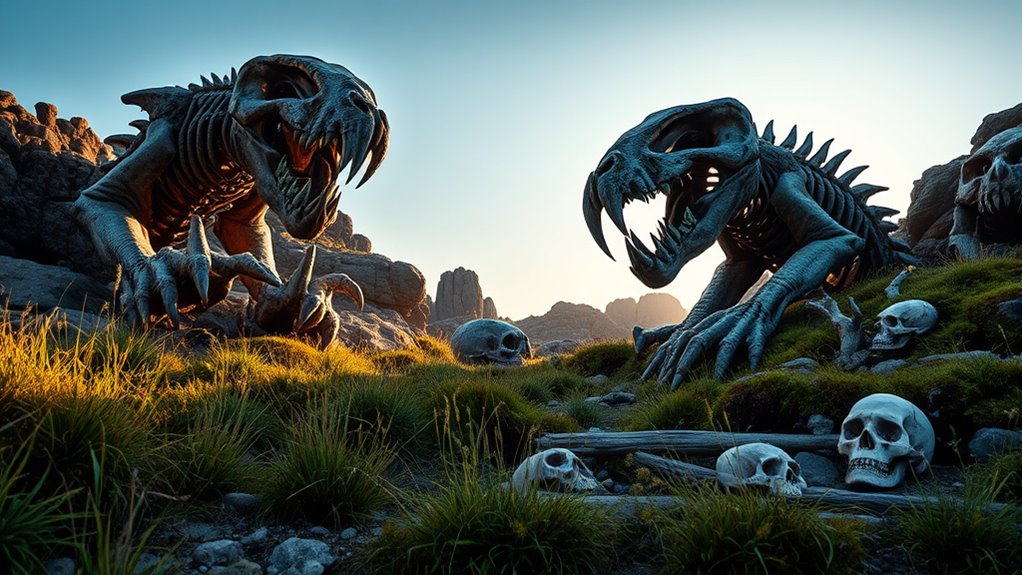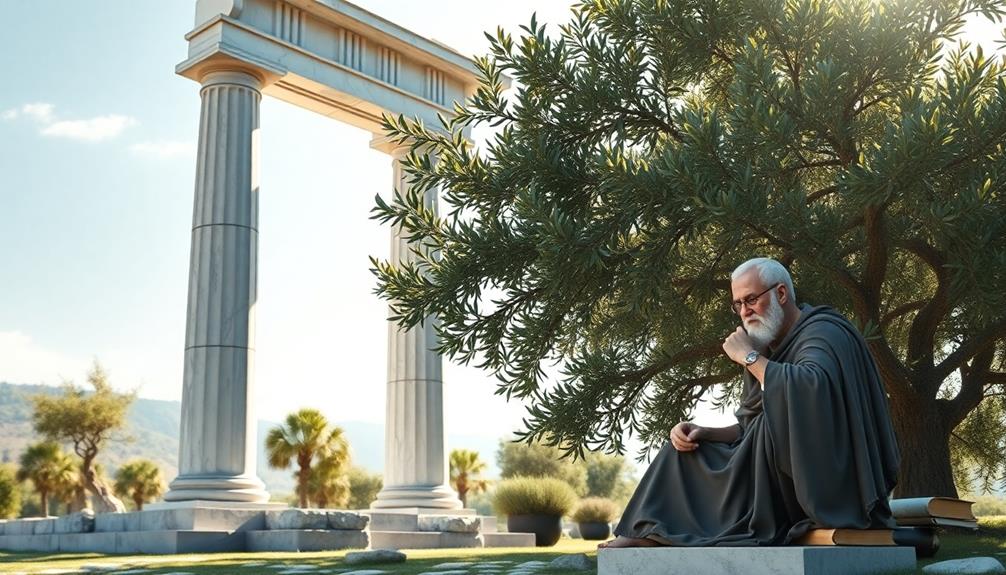Ancient Greeks likely crafted their myths of monsters inspired by fossils of now-extinct megafauna they discovered or believed to encounter. Fossil remains of giant animals, like elephants or prehistoric reptiles, might have appeared mysterious or monstrous, fueling stories of creatures like the Hydra or Cyclops. These myths served as symbolic interpretations of natural phenomena and unfamiliar bones. If you explore further, you’ll uncover how these ancient stories are rooted in real prehistoric encounters and fossil discoveries.
Key Takeaways
- Ancient Greeks may have interpreted fossils of giant animals as evidence of mythical monsters.
- Fossilized bones of megafauna could have inspired stories of legendary creatures like the Cyclops or Chimera.
- Myth creation often involved transforming tangible fossil remains into symbolic beings reflecting natural fears.
- Archaeological finds of large prehistoric bones support the idea fossils influenced Greek monster myths.
- Cultural narratives incorporated fossil evidence to explain mysterious or unfamiliar natural phenomena.

Have you ever wondered whether some of the legendary monsters from folklore could have been inspired by real megafauna? It’s a fascinating idea to consider, especially when you look at how ancient cultures interpreted unfamiliar creatures. The ancient Greeks, for example, created mythological beings that seem to echo the features of enormous animals whose fossils they might have uncovered. These myths didn’t emerge in a vacuum; they often carried deep cultural symbolism, representing fears, natural forces, or societal values. When you examine archaeological evidence, you notice that some of these stories could be be rooted in encounters with massive, now-extinct animals, which left behind bones and fossils that early humans found puzzling or awe-inspiring.
Ancient myths may stem from encounters with now-extinct megafauna’s mysterious fossils.
Cultural symbolism plays a vital role here. For the ancient Greeks, monsters like the Hydra, Chimera, or the Cyclops weren’t just scary stories—they embodied complex ideas. The Hydra, with its many heads, could symbolize chaos or the threat of natural disasters, while the Cyclops might have represented the raw power and mystery of the wilderness. These beings could be inspired by encounters with large, unfamiliar animals, whose remains were mistaken for the bones of monsters. When early humans stumbled upon giant skulls or bones, they might have interpreted them through their mythological lens, shaping stories that reflected their understanding, fears, or societal values. Additionally, the discovery of fossilized megafauna remains could have provided tangible evidence that fueled such myth-making.
Archaeological evidence supports this idea. Fossilized remains of megafauna such as giant elephants, large prehistoric whales, or giant reptiles have been found in regions inhabited by ancient civilizations. Some of these fossils are so unusual that they could have easily been mistaken for the remains of mythical beasts. For example, the discovery of large, tusked bones might have led people to imagine a monstrous creature, fueling stories that grew over generations. These tales could then be woven into cultural narratives, serving as allegories for natural forces or moral lessons.
Furthermore, the Greeks often personified natural phenomena through myth, and the discovery of strange fossils could have reinforced these stories. Over time, the interpretation of these fossils would evolve into mythic creatures, embodying the fears and ideals of the society. In this way, ancient myths might have originated from real encounters with megafauna, transformed through cultural symbolism into legendary monsters. So, when you think about Greek monsters, it’s worth considering that behind their fearsome appearances, there might be a kernel of truth rooted in ancient encounters with the giant animals that once roamed the earth. Recognizing the fossil record helps us understand how ancient peoples might have interpreted the natural world around them.
Frequently Asked Questions
What Specific Fossils Might Have Inspired Greek Monster Myths?
You might find fossilized bones of large animals, like mammoths or giant reptiles, that sparked myth origin analysis. These fossils, with their unusual shapes, could have led to stories of monsters like the Chimera or Hydra. By fossil identification, ancient Greeks may have interpreted these remains as the remnants of mythical creatures, blending real fossils with their imagination to create legendary monsters.
How Did Ancient Greek Culture Interpret Unusual Animal Remains?
You see, ancient Greek culture often interpreted unusual animal remains as fossil symbolism, believing they held divine or mythical significance. These discoveries fueled myth making processes, inspiring stories of monsters and gods. When you encounter such fossils, you can imagine how early Greeks might have seen them as evidence of extraordinary creatures, blending real remains with myth to explain the mysterious and the unknown in their world.
Are There Similar Fossil-Influenced Myths in Other Ancient Civilizations?
You’ll find that many ancient civilizations wove prehistoric narratives into their cultural symbolism, creating myths influenced by fossil discoveries. For example, Chinese legends mention dragon-like creatures inspired by fossils, while Aboriginal Australian stories incorporate unusual bones into Dreamtime tales. These stories reflect a universal human tendency to interpret mysterious remains as supernatural beings, illustrating how fossil-influenced myths span across cultures, enriching our understanding of early human imagination and beliefs.
What Role Did Geography Play in Greek Fossil Discoveries?
You should consider that geography greatly influenced Greek fossil discoveries, as the geographical distribution of fossils varied across regions. Fossil locations in Greece’s rugged terrain and sedimentary layers made it easier for ancient Greeks to find bones and remains. These discoveries were often linked to local myths, shaping their stories. Your awareness of how different regions’ fossil deposits contributed to myth formation can deepen your understanding of Greek culture and natural history.
Can Modern Science Identify the Real Animals Behind Mythological Creatures?
A picture is worth a thousand words, and modern science can often identify the real animals behind mythological creatures through fossil identification. You can analyze fossils to uncover origins of myths, linking legends to ancient megafauna or fossils. While some myths may stem from misinterpreted fossils, others remain purely imaginative. Science helps you trace myth origins, but not all legends have a fossil-based story behind them.
Conclusion
So, next time you hear about mythical monsters or legendary beasts, remember—they might just be ancient Greeks’ wild guesses at real, towering fossils. Could it be that our entire mythic universe is actually a colossal fossil-fueled fantasy? Maybe those ancient stories are less fiction and more prehistoric truth, hiding in plain sight. Who knows? Maybe, just maybe, the monsters of legend are actually the giants of the past, waiting to be rediscovered!








